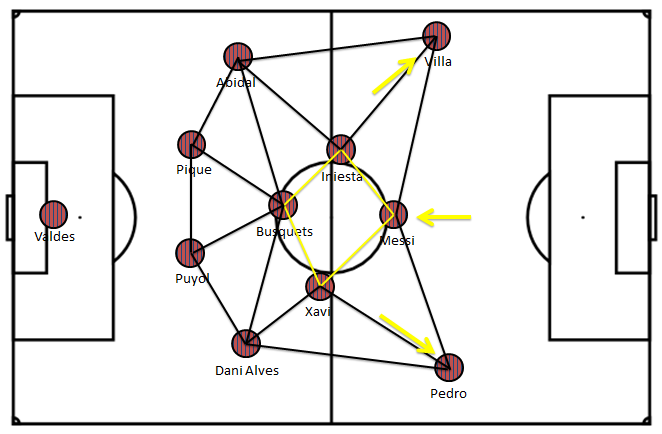Shapes

Football is a simple sport really when you break it down. Get the ball from point A in your half to point B in the opponent's half sometimes going through point C, D, E etc and when you get close enough, kick the ball in the goal and repeat.
Someone get a phone quick and ring the City board and give Pep his notice. I can start next week.
But seriously, football need not be overly complicated with tactic boards and overly complicated methods of getting the ball from point A to point B and beyond. Even the most basic knowledge of maths and geometry is all that you need.
Take a minute, and put your phone down or look up from your tablet or laptop and look around the room or space you are in. You'll notice lots of random shapes. Pick out the simplest ones. You've likely landed on squares, rectangles, circles or triangles. Which shape am I bringing your attention to? That's right, it's the triangles.
If you look at any football match on TV, especially if the football match is one with a manager who has employed a 4-3-3 formation it's literally all about triangles. Every connection made between the various players forms a triangle. Look out for it the next time you watch a football match on the TV. Watch the movement of the players. As soon as the team gains possession, their team mates closest to them will form a triangle of possible passing paths. It will repeat over and over and over again throughout the match. Any match will have hundreds if not thousands of these triangular passing shapes or at the very least potential triangular passing shapes.
Is there an advantage to triangles?
Yes there is. Allow me to try to explain it to you. This comes from some text another coach at my club in Galway sent to me a while back and I do not know the source or whether it was his own words. Anyway, this is what he said:
"If three players on the pitch form a right-angled triangle when a line is drawn between them, then the two players who are positioned at the ends of the hypotenuse are closer to the third player. They have to play the longest pass between each other and short passes with the third player. This leads the defender to run more distance along the hypotenuse and less distance along the other two sides.
Hence forward balls should be played to the farthest player in the triangle which increases the spacing between them. As an effect it becomes harder for the defending team to intercept passes, close down opponents with the ball, and mark the players without it.
The other effect it has is spacing the players of the defending team away from each other so that they cannot keep a compact shape or press in numbers. This reduces more of the game to one on one battles and favours the team who has better technique and tactical organisation to pass the ball and keep possession"
4-3-3 triangles
If we have a look at the popular 4-3-3 formation made famous by Pep Guardiola when he was with Barcelona, what's immediately clear if we draw it on paper is the number of triangle passing lanes we can create right across the pitch.

With this formation, we can have every player be part of at least one positional triangle in relation to his/her teammates. There are thousands of possible combinations of passes that the players can make and the path that the ball can travel. Messi, Xavi and Iniesta used thousands of these triangles every week when their Barcelona team was dominating world football.
The 4-3-3 formation creates natural triangles, often giving the player in possession several passing options at any given time, which is key. This makes implementing a possession-based style of play slightly easier than some most other formations.
A three-player midfield unit like the one mentioned above can create overloads in central areas, which will further help attempts to dominate possession. A striker dropping back or an inverted full-back can add another body in midfield when needed.
4-3-3 fosters attacking prowess as we end up with lots of avenues for moving the ball forward to more attacking positions on the pitch. Of course we need balance in a team, but 4-3-3 is also good for the high pressing game popular with teams like Arsenal and Liverpool especially. Here a three-man forward line provides good numbers to apply pressure on the opposition defence when they try to play out from the back. The midfield trio from above then provides cover and protection in central areas.
Applying it to my team

I currently coach an under 11s football team but this year it's seven aside. Next year it's going to be nine aside. As such the four three three formation doesn't quite work yet however the triangles can still work at 7 aside.

We tend to set up with a 2-3-1, which still allows for lots of triangular movement. I don't tell the kids about the triangles, as I don't want to confuse them, but during our three training sessions each week, my passing drills always involve triangular passing and movement.
Let me know your thoughts
I'd love to hear your thoughts about these triangles!
Do you coach a team?
What formation do ye play?
What formation do you enjoy watching?
Let me know in the comments below.
Also a quick doff of the hat to @cryptoandcoffee who keeps this community running and a tag to @niallon11 @blanchy @seki1 @pele23 @sports.guy55 and @talesfrmthecrypt who know their football, albeit this shape for you @sports.guy55 🏈
I thought you might still have an opinion here .
https://medium.com/@Brownyyy26/the-false-9-f4cac8ed5b36
Thanks a million for reading my post
Peace Out

